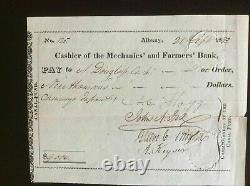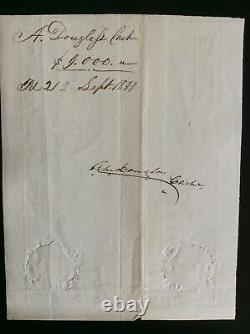
- Index
- Binding
- Conflict
- Region
- Subject
- Americana (17)
- Andrew Jackson (4)
- Civil War (42)
- Civil War, Men (6)
- Collectible (10)
- Family (3)
- Figures & Portraits (11)
- Historic & Vintage (3)
- History (60)
- Law & Government (3)
- Literature & Fiction (7)
- Men (9)
- Men, Civil War (89)
- Men, Military (28)
- Military (69)
- Military & Political (102)
- Military & War (179)
- Military, Political (6)
- Portrait (6)
- Presidents (5)
- ... (3435)
- Theme
- Americana (9)
- Antique (2)
- Army (3)
- Art (5)
- Celebrities (2)
- Civil War (10)
- Civil War General (2)
- Conflicts & Wars (7)
- Cosplay (2)
- History (10)
- Man, Portrait (2)
- Militaria (1098)
- Militaria, People (5)
- Militaria, Portrait (4)
- Military (2)
- Military & Adventure (13)
- Politics (6)
- Portrait (30)
- Portrait, Man (21)
- ... (2861)
- Year Printed
1833 SIGNED CHECK JOHN A DIX Civil War Major GeneralNY Draft RiotsErie Canal




1833 Check Signed by Future Union General John A. Dix as Commissioner of New York's Erie Canal Fund. This is an 1833-dated check drawn on the Mechanics' and Farmers' Bank by four commissioners of New York State's Erie Canal Fund. The signers are former New York Secretary of State Azariah C. Flagg, New York Attorney General Greene C.
Bronson, future Union Major General John A. Dix, who was then Secretary of State for New York as well as Adjutant General of the New York State Militia, and a person named A.
The check measures about 6 3/4" x 5 1/2" and is in very good condition. There are two bank cancellation marks which have weakened the paper in those areas.
John Adams Dix (July 24, 1798 - April 21, 1879) was Secretary of the Treasury, Governor of New York and Union major general during the Civil War. Dix was born in Boscawen, New Hampshire, the son of Timothy Dix and Abigail Wilkins, and brother of composer Marion Dix Sullivan. He was educated at Phillips Exeter Academy, and joined the US Army as an ensign in May 1813, serving under his father until the latter's death a few months later. He attained the rank of captain in August 1825, and resigned from the Army in December 1828.In 1826, Dix married Catherine Morgan, the adopted daughter of Congressman John J. Morgan, who gave Dix a job overseeing his upstate New York land holdings in Cooperstown. Dix and his wife moved to Cooperstown in 1828, and he practiced law in addition to overseeing the land holdings.
In 1830, he was appointed by Governor Enos T. Throop as Adjutant General of the New York State Militia, and moved to Albany, New York. He was Secretary of State of New York from 1833 to 1839, and a member of the New York State Assembly Albany Co.
Dix was elected as a Democrat to the United States Senate to fill the vacancy caused by the resignation of Silas Wright, Jr. And held office from 1845 to 1849. In November 1848, he was the Barnburner/Free-Soil candidate for Governor of New York, but was defeated by Whig Hamilton Fish. In February 1849, he ran for re-election to the U.
Senate as the Barnburners' candidate, but the Whig majority of the State Legislature elected William H. In 1853 Dix was president of the Mississippi and Missouri Railroad.
He was appointed Postmaster of New York City and served from 1860 to 1861. He was the figurehead for rail baron Thomas C. Durant, in both of his railroad presidencies. He was also briefly President of the Erie Railroad in 1872. Dix was appointed United States Secretary of the Treasury by President James Buchanan in January 1861.At the outbreak of the Civil War, he sent a telegram to the Treasury agents in New Orleans ordering that: If any one attempts to haul down the American flag, shoot him on the spot. Although the telegram was intercepted by Confederates, and was never delivered to the Treasury agents, the text found its way to the press, and Dix became one of the first heroes of the North during the Civil War. The saying is found on many Civil War tokens minted during the war, although the wording is slightly modified.
At the start of the American Civil War, Dix was appointed a major general in the New York Militia. He joined the Union Army as the highest ranking major general of volunteers during the war, effective May 16, 1861; also appointed on that day were Nathaniel P.
Banks and Benjamin Franklin Butler, but Dix's name appeared first on the promotion list, meaning that he had seniority over all major generals of volunteers. In the summer of 1861, he commanded the Department of Maryland and the Department of Pennsylvania.His importance at the beginning of the Civil War was in arresting six members of the Maryland General Assembly and thereby preventing the legislature from meeting. This prevented Maryland from seceding, and earned him President Lincoln's gratitude.
That winter, he commanded a regional organization known as "Dix's Command" within Maj. McClellan's Department of the Potomac.Dix commanded the Department of Virginia from June 1862 until July 1863, and the Department of the East from July 1863 until April 1865. This agreement became known as the Dix-Hill Cartel.
It established a scale of equivalents, where an officer would be exchanged for a fixed number of enlisted men, and also allowed for the parole of prisoners, who would undertake not to serve in a military capacity until officially exchanged. The cartel worked well for a few months, but broke down when Confederates insisted on treating black prisoners as fugitive slaves and returning them to their previous owners. On October 10, 1862, Lincoln's Secretary of the Navy, Gideon Welles wrote that "a scheme for permits, special favors, Treasury agents, and improper management" existed and was arranged by Treasury Secretary Salmon P. Chase for General John A.The motive of Chase appeared to be for political influence and not for financial gain. Dix was considered too old for field command. Some believe that his most distinguished contribution to the war was the suppression of the New York City draft riots in July 1863, although the rioting had already subsided by the time he replaced General John E. He was also active in the defense of Suffolk, which was part of his department. He served as the temporary chairman of the 1866 National Union Convention.
He was United States Minister to France from 1866 to 1869. He was Governor of New York from 1873 to 1874, elected on the Republican ticket in November 1872, but was defeated for re-election by Samuel J. He suffered another defeat when he ran for the Mayor of New York City in 1876. A fantastic item for the collector of historical military/political autographs!Also, a wonderful idea for a family member to add to their archives! (Inventory: Autograph Closet; Envelope 8). This item is in the category "Collectibles\Autographs\Military".
The seller is "ron-likes-history" and is located in this country: US. This item can be shipped worldwide.- Original/Reproduction: Original
- Signed by: John A Dix
- Category: Military
- Guaranteed Authentic: Yes
- Autograph Type: Authentic Original

